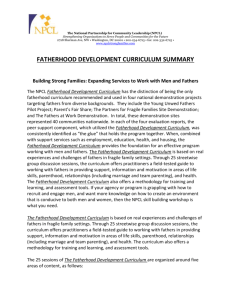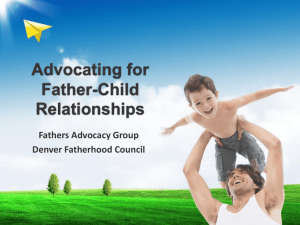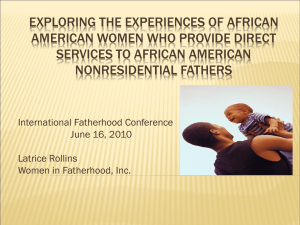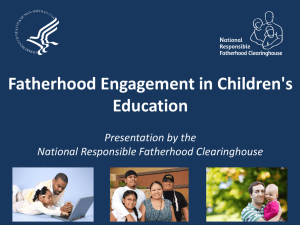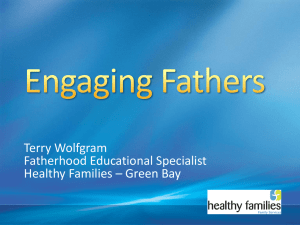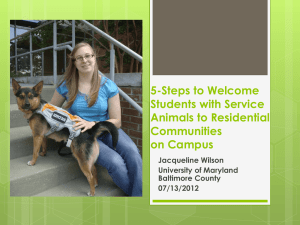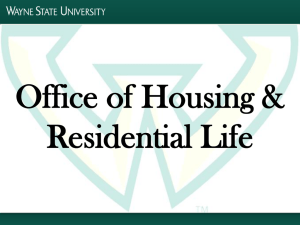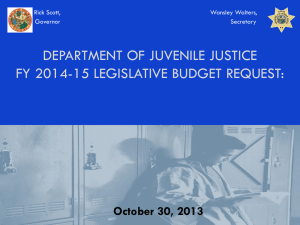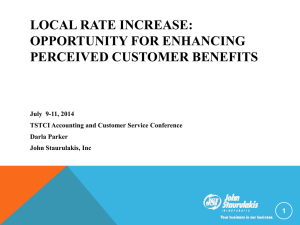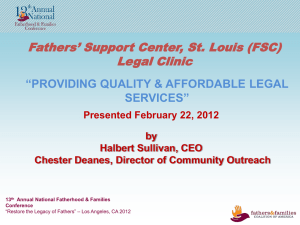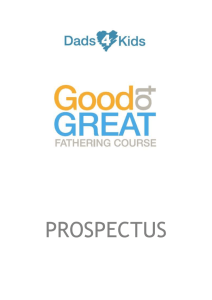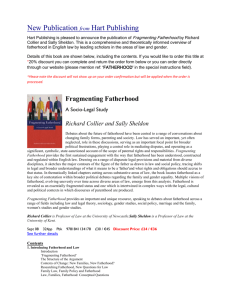Promoting Father Engagement: Program Outcomes and Lessons
advertisement
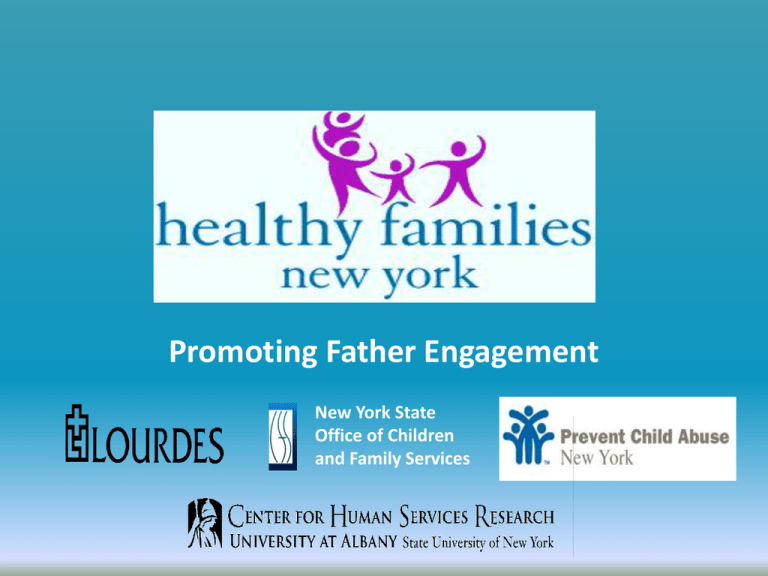
Promoting Father Engagement New York State Office of Children and Family Services Tom Dwyer Program Contract Manager Office of Children and Family Services New York State Office of Children and Family Services Agenda • Fatherhood Initiative of Healthy Families New York – Tom Dwyer, OCFS • Research Findings on Father Involvement – Matt Vogel, Center for Human Services Research • Is Your Organization Father Friendly? – Audience Participation • Engaging Fathers in Program – Corina Allen & Matt Scott, Healthy Families Broome About HFNY • Healthy Families New York (HFNY) is a voluntary home visiting program for expectant and new parents. • 36 Programs in Upstate New York and in NYC serve 5700 families annually • Paraprofessionals provide home visits Partners with Healthy Families New York NYS Office of Children and Family Services Center for Human Services Research Prevent Child Abuse New York Goals of our program • Support positive parent-child bonding and relationships • Promote optimal child health and development • Enhance parental self sufficiency • Prevent child abuse and neglect HFNY Fatherhood Initiative The mission of the HFNY Fatherhood initiative is to engage fathers and support them in their parenting role to enhance child developmental outcomes and longterm family success. HFNY Fatherhood Initiative Services • Modes of Service Delivery – Tandem home visits where FSW and FA work with mother and father together. – One-on-one sessions where FA works with just the father and child. – Fathers’ groups where the FA works with a group of fathers together. – Individual FSW works with entire family HFNY Fatherhood Initiative Services • Services Provided – Provide information on parenting skills, child development and PCI. – Focus on relationship with parent(s) of child. – Teach importance of fathers to families. – Set specific goals. Matt Vogel Research Scientist Center for Human Services Research Importance of Father Involvement • A considerable body of research has accumulated on the importance of fathers in healthy child development (Rosenberg & Wilcox, 2006). – – – – Cognitive Development School Readiness Emotional Well-Being Social Development CHSR Fatherhood Study • Purpose – What does father involvement mean? – What types of families have actively involved fathers? – What are the outcomes of father involvement? • Retention • Number of Visits – Does having an active Fatherhood component increase father participation? • Sample – 2,433 families enrolled in HFNY during 2009 and followed through 2011. Measuring Father Involvement in Program • Four Types of Father Involvement in Program – – – – Residential and Involved Residential and Non-Involved Non-Residential and Involved Non-Residential and Non-Involved Measuring Father Involvement Father Involvement in HFNY: 2009 Cohort 50.0% 45.0% Percent of Families 40.0% 35.0% 30.0% 25.0% 20.0% 15.0% 10.0% 5.0% 0.0% 3.7% Residential / Involved 36.8% 15.7% 43.8% Residential /Non- Non- Residential / Non- Residential / Involved Involved Non-Involved Characteristics of Families with Involved Fathers • Relative to all other HFNY families... – Mothers with Residential and Involved fathers are more likely to be married and to have graduated high school. – Mothers with Residential and Non-Involved fathers are more likely to be married, white, hold a HS diploma or higher, and are typically older and present with lower risk scores. – Mothers with Non-Residential and Involved father are less likely to be married. – Mothers with Non-Residential and Non-Involved father are more likely to be black, non-married, have dropped out of high school, and are typically younger and present with the highest risk scores. Effects of Father Involvement Months Involved in Program* Months Involved in Program 18.0 16.0 14.0 12.0 10.0 8.0 6.0 4.0 2.0 0.0 16.9 Residential / Involved 12.2 15.8 9.5 Residential /Non- Non- Residential / Non- Residential / Involved Involved Non-Involved *Holding constant Mother’s age, race, education, marital status, Kempe Score, and flag for NYC. Estimates adjusted for program effects. Effects of Father Involvement Number of Visits for HFNY Families * 35.0 Number of Home Visits 30.0 25.0 20.0 15.0 10.0 5.0 31.7 0.0 Residential / Involved 25.7 29.1 24.7 Residential /Non- Non- Residential / Non- Residential / Involved Involved Non-Involved *Holding constant Mother’s age, race, education, marital status, Kempe Score, and flag for NYC. Estimates adjusted for program effects. Effects of Father Advocate Component Percent of Home Visits Involving PC2 45.0 Percent of Home Visits 40.0 35.0 30.0 25.0 20.0 15.0 10.0 5.0 0.0 40.3 30.81 34.5 Biological Father FA Site 28.88 Grandparent Non-FA Site Key Findings • There are clear differences in the level of father involvement among HFNY families – These differences are linked to socio-economic, demographic, and regional differences between families. • Families with active father involvement: – Involved with HFNY for longer. – Have more home visits. • Sites with a Fatherhood Component: – Involve fathers in roughly 6% more home-visits than non-FA sites. Activity Discussion Questions • What are the strengths of your program in involving fathers? – How does your program involve fathers? • What types of services do you provide? • What kinds of activities do you engage in? • What are the barriers your program encounters in involving fathers? – What are the challenges you face? – How do you try to overcome those challenges? • What did you learn from this activity after discussing fatherhood involvement with your neighbor? Corina Allen Family Service Worker and Senior Parent Educator Healthy Families Broome Matt Scott Family Service Worker Healthy Families Broome Fatherhood Initiative Timeline 7 6 5 4 3 2 1 0 # of FA Assessment/Outreach Include male figure on assessment . First impressions. Establishing Initial Relationships • Expectation to have Dad at enrollment and visits. – More fathers say they are influenced by the way they were raised than mothers (59% vs. 50%) (Hart Research Associates, 2010). • Gather information for both parents. – PSI, survey, ASQ. Family as a whole unit • Fathers are 3X more likely than mothers to turn to their spouse for parenting information (Hart Research Associates, 2010). • Research shows that when there is a father-figure involved children do better in school and with relationships of their own in the future (Pruett, 2000). Tandem visits • How we do tandem visits • Who we work with Communication styles • Multiple conversations going on during visits • Alternate use of electronic media to communicate with dads • Using curriculum that is father friendly • Dads play differently with children (dads are physical, moms nurturing) • FAs relate on a different level with dads than FSWs could Child abuse prevention • Boyfriends are the highest perpetrators for child abuse. • We include any male figure in the home on the visits. Challenges • Worker Safety – For FSWs – For FAs – Liability • Scheduling – With the Family – With other Family Support Workers • Father involvement – Initial Visit – Program for FAMILY not just Mom • Curriculum – Dad friendly – Family oriented Retention rates • Extended leave of absence of FSW. • FSW resigning – retain families with FA more than those without being transferred to new FSW. • Seamless transfer of families to FA. • Families who split up – we continue to serve both Mom and Dad. • Built rapport with the families. Resources The National Fatherhood Initiative http://www.fatherhood.org/ OCFS Fatherhood Initiative http://www.ocfs.state.ny.us/main/fatherhood Healthy Families New York http://www.healthyfamiliesnewyork.org/ HFNY Newsletter on Father Involvement http://www.healthyfamiliesnewyork.org/Media/newslett ers/link-winter_%202012_final.pdf Contact Information Tom Dwyer Office of Child and Family Services Thomas.Dwyer@ocfs.state.ny.us Matt Vogel Center for Human Services Research mvogel@albany.edu Corina Allen Healthy Families Broome County caallen@lourdes.com Matt Scott Healthy Families Broome County mscott@lourdes.com
